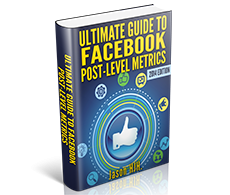So you’re probably familiar with all the things you should be doing on Facebook. In short, they can be summarised as:
- Creating great relevant content
- Monitoring other relevant Facebook Pages, including competitors and aspirational brands
- Engaging with your community
You can read more about the CME framework here.
Recently, I’ve grown to like the idea of brand accretion. I believe that marketing, while achieving short-term goals for your business, should gradually grow the value of your brand. And this can be easily achieved on Facebook if we make a conscious and consistent effort to do so.
The way to go about building your brand equity through Facebook is to focus on amplifying your brand personality so that your customers become so acquainted with your brand that they’re able to describe it as if it was a living person. So here’s a guide I’ve ready to help you do that:
Principle #1 to amplify your brand personality: Be Yourself
You probably have a list of ideal traits for your brand. Keep those and add the above to your list.
Here’s why - the only thing unique about any brand is the brand! By being yourselves, you’re already different from someone else, even if he is trying to copy you. Incidentally, doing so - something which only you guys know how to exactly - will create a moat that keeps others away.
Just imagine, you run an e-commerce business selling NATO straps. Your customers love your product and take photos of their watches with the straps replaced. With Instagram, you know that some of your customers love to share these photos online. Then, you often hear from customers who are worried that the strap colours may not match their watches, so you decide to encourage your existing customers to showcase their collections and share these photos on your Instagram account. By doing so, you attract even more eyeballs and customers - eyeballs who love watches but not necessarily buy your product (just yet). These people form part of the group that are acquainted with your brand and if they have a friend who needs to change their watch straps, your brand will be at the top of their minds and they will almost certainly recommend it to them. The stronger your brand acquaints with them, the more likely they’ll remember and share with their friends. And this is what happened to me when a friend of mine recommended me to buy NATO straps from this e-commerce store. And they manage an Instagram account which has shared over 700 of their customers’ watches till date, while attracting over 4600 followers. That’s a pretty high photo:followers ratio.
Perhaps the above example was not good enough to illustrate what I mean. But my point is this - your uniqueness helps others identify and remember you. It will also guide you to do things your way. These are what people remember you for. For instance, you know your friends by name and you kind of have an idea what their individual personalities are like, and when a name comes to mind, you associate them either with positive or negative feelings. Being yourself will not prevent others from associating with your brand negatively if you make mistakes, but it will help to amplify your brand personality and positioning, differentiating it from other brands.
How you can “be yourself” as a brand: Apart from doing things your way, you should also allow your customers to see the people behind your brand. This means conducting personal interviews of everybody who’s involved in the business (See the above picture as an example). I’d urge you to go beyond just the founders of the business to include the employees. It’s not necessary that you include direct quotes from the interviewees - narratives are fine. In fact, I’d caution you when using quotes because you might sound too cheesy, unless that’s the essence of your brand.
In short, you should do the following to “be yourself”:
- Do things your way
- Feature the people behind your brand
- Feature behind-the-scenes such as “a normal day at work”
Principle #2 to amplify your brand personality: Share your Beliefs
This is simpler to understand. When you decide to serve the customers you’re serving, you must have some shared beliefs. Airbus believes that they can help airlines increase revenue, expand traffic routes, and attract more customers. So they have a tagline, “Own the sky.” Twitter believes that users can find real-time information and connect in real-time with others. So they promise, “Find out what’s happening, right now, with the people and organisations you care about.” And it goes beyond just taglines and promises to sharing quotes that resonate with their beliefs. For example, we shared a simple quote on a client’s Facebook Page, which aimed to foster a stronger sense of identity among volunteers:
The fans LOVED it!
Furthermore, you should also include some of the beliefs that your business believe in - remember “Be Yourself”?
So here’s what I recommend: Share the CSR work that your business does on Facebook. Share authentic and unedited photos.
How you can share the beliefs of your brand: Before you do this, make a list of your brand’s beliefs, shared beliefs between you and your customers, and other possible beliefs that your customers have which are not on your list yet. Experiment sharing these possible beliefs and see if they resonate with your fans on Facebook. You may well discover and get new insights about your fans that you never knew!
In short, you can share the beliefs through:
- Posting relevant quotes
- Up your game and combine quotes with impactful visuals
- Share photos and reflections (from participants) of your CSR efforts
Principle #3 to amplify your brand personality: A list of “What to do & not to do”
Granted, your Facebook Page is likely managed by an agency or a in-house social media person. If you’re a social media person, you probably know that you have in your hands a very powerful tool that could much impact your company. Just look at Amy’s Baking Company “epic” meltdown on Facebook to understand the magnitude of grave mistakes on social media.
How you can come up with a list of “What to do & not to do”: To help you come up with your “what to do & not to do” list, I’ll use an example from a client. This client is a commercial interior design studio serving both real estate companies and homeowners to design their showrooms and living spaces:
- Because it needs to speak to real estate companies, the tone we use is business-like, but rest on the borders of casual business and being too formal. We also limit our use of exclamation marks (!) to 1 every Facebook post.
- Because Facebook is a social platform, we wanted to use conversational English, NOT Singlish (a local slang). We also avoid using too many commas (as you would when listing 3 things in a sentence), and allow our posts to begin with words such as “So” & “And”, a practice not “allowed” in written English.
- Because design narratives are at the core of my client’s work, showcasing their work often involves making the narratives come to life. Thus we do not impose word limits for our Facebook posts, despite all the statistics that shorter Facebook posts tend to have more engagement. In fact, we’ve consistently achieved more than 10% engagement rate despite our length Facebook posts.
I’d like to take this chance to talk about the danger of making decisions from such statistics. The data above is a result of exploratory research, a research technique that helps the researcher find possible causes of a phenomenon. In this case, the phenomenon is higher engagement rates. However, the keywords are “find possible causes”, not “prove cause-and-effect relationship” between the length of Facebook posts and the engagement rates. By making decisions on such statistics, we tend to allude to the idea that “if I cut the length of my Facebook posts, my engagement rates should increase.” This is simply NOT TRUE.
Besides, such statistics are often the result of a “flaw of averages”. In reality, lengthy Facebook posts are often the result of poor writing practices and the length is often not well-intended, unlike the example of our client above. On the other hand, many short Facebook posts include meaningless memes that generate cheap but irrelevant engagement. Thus, I urge you to look beyond the length of your Facebook posts and such hyped statistics to focus on the real quality of your Facebook posts.
- Many short Facebook posts include meaningless memes that generate cheap but irrelevant engagement Tweet
Hopefully by the end of this post, you understand that your daily Facebook marketing efforts can help you build a valuable brand in the long-term, while meeting short-term marketing goals.
If you’ve any questions, please comment below and I’ll get back to you shortly.
Useful resources
- Non Gamstop Casinos
- Non Gamstop Casinos
- Non Gamstop Casinos
- Casino Not On Gamstop
- Casino Non Aams
- Non Gamstop Casino
- Casino Sites Not On Gamstop
- UK Casinos Not On Gamstop
- Casinos Not On Gamstop
- Online Casinos UK
- Best Non Gamstop Casinos
- Sites Not On Gamstop
- Non Gamstop Casino UK
- Best Non Gamstop Casinos
- UK Casinos Not On Gamstop
- Non Gamstop Casinos UK
- UK Casino Sites
- Non Gamstop Casino Sites UK
- Casino En Ligne
- Meilleur Casino En Ligne
- Non Gamstop Casinos UK
- Non Gamstop Casinos
- UK Online Casinos Not On Gamstop
- Casino Sites Not On Gamstop
- Casino En Ligne Crypto
- Casino En Ligne
- Meilleur Casino En Ligne Belgique
- Siti Non Aams Scommesse
- 코인카지노
- バカラ カジノ
- 익명 라이브 카지노



Pingback: Enough: 5 Worst Pieces of Advice I heard in January about Facebook, and many people listen to them!